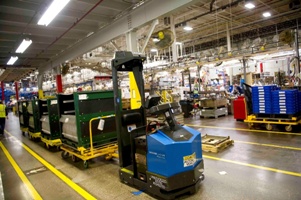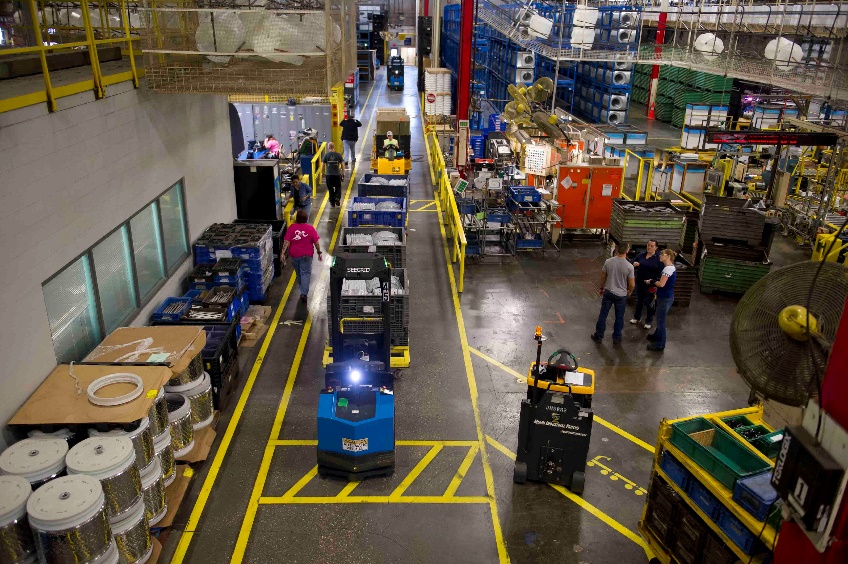Machines on the plant floor will soon actively identify problems, determine a course of action, execute, and measure those results – all without human interaction.
The Industrial Internet of Things (IIoT), as it’s known, is already beginning to reshape manufacturing. Though many manufacturers are just starting to explore the implications of IIoT, the Internet of Things (IoT) has been generating buzz for years and already represents a booming market opportunity.
The Internet of Things refers to a network of physical objects equipped with sensors that collect data and “communicate” that data to other machines (or back to humans) instantaneously. Built on cloud computing, this machine-to-machine interaction is set to make everything in our lives “smart,” from thermostats that set themselves to refrigerators that reorder our milk, says Jim Rock, CEO, Seegrid.
One McKinsey report estimateed that Internet of Things (IoT) will have a potential economic impact of up to $6.2 trillion by 2025. Given those estimates, many manufacturers are embracing the transition to the Industrial Internet of Things (IIoT) as a natural next step in the innovation lifecycle. A recent study by PwC found that 34% of manufacturers believe it is “extremely critical” that US manufacturers adopt an Internet of Things strategy in their operations.
In MHI’s 2016 Annual Industry Report, 47% of 900 respondents felt sensors and automatic identification technologies have the potential to either create competitive advantage or disrupt supply chains. Forty-four percent of respondents are currently using these technologies and 87% expect to be using them in five years.
 Predictive analytics and cloud computing technologies were also covered in the report, with almost half (45%) of respondents saying they currently utilise cloud computing in their supply chains. Another 22% say they expect to implement the technology within the next one to two years and adoption rates are expected to surge to 86% over the next six to ten years.
Predictive analytics and cloud computing technologies were also covered in the report, with almost half (45%) of respondents saying they currently utilise cloud computing in their supply chains. Another 22% say they expect to implement the technology within the next one to two years and adoption rates are expected to surge to 86% over the next six to ten years.
Additionally, 44% of MHI’s respondents said that predictive analytics has the potential to be a disruptive or competitive force in their industry. While the adoption rate for predictive analytics in supply chains stands at just 22%, it is expected to grow to 80% over the next six to ten years.
IoT is an ever-growing network of interconnected devices, people, and machines which are forecasted to have an economic impact of up to $11.1 trillion by 2025. It is transforming industry and bringing many opportunities with it. The so-called Fourth Industrial Revolution, or Industry 4.0, is a collective term embracing a number of contemporary automation, data exchange, and manufacturing technologies, especially in the industrial setting.
Global insurer Allianz Global Corporate and Specialty looked at smart factories of the future, reporting that as the “Internet of Things” evolves, tomorrow’s factories will look much different from today’s. Products will “move themselves” along the line. Augmented reality software will allow employees to learn new tasks quickly. Products will “predict” when they need a tune-up. Replacement parts will be made on-the-spot with 3D printers. Some factories are already there.
Allianz acknowledged the benefits include connected processes, product customisation, and speed-to-market. Businesses stake considerable capital investment on promises of economic growth and other value-adds like reduced downtime and increased efficiencies. Success stories of pioneer companies that reap quantifiable benefits like near-100% quality control help convince cost-wary manufacturers.
Big Data, Big Results
Increasingly, manufacturers are using big data and advanced analytics to scrutinise the massive amounts of data being collected by their smart machines. These evaluations are yielding valuable insights into plant workflows, including predicting maintenance needs before equipment breaks and tracking parts as they move through the supply chain.
By remotely monitoring product performance, companies are able to prevent unplanned maintenance and parts loss, dramatically reducing downtime and enhancing productivity. They’re then able to pass these insights onto their customers, improving customer service and even—some studies suggest—creating new revenue streams. In surveying more than 1,400 C-suite decision makers, Accenture found that the vast majority (84%) believe their organisations have the capability to create new, service-based income streams from the IIoT.
Similarly, PwC predicted that manufacturers will continue to unlock new “product-as-service” models based on their ability to gather big data and provide their customers with actionable recommendations for improvement based on their findings.
How VGVs Play in IIoT
Ahead of many other machines on the factory floor, VGVs themselves are sensors that accurately and consistently capture performance data. Employing Vision technology, VGVs gather thousands of important data points per second, and provide insights into distance traveled, total errors, obstruction hours, follow hours, motion hours, powered hours, and rescue hours.
Arguably as important as collecting these data points is conveying them to the end-user (in this case, plant managers) in a way that is both comprehensive and intuitive, whether through fleet data reports or easy-to-use dashboards. Importantly, this allows the plant manager to identify inefficiencies and potential problems before they affect throughput productivity.
Increasingly, companies like Seegrid that are invested in IIoT continue to release dynamic metrics to improve enterprise-wide global operations. In the future, VGVs will use big data to identify problems, as well as execute a solution, and measure the results—all without human interaction.
Innovative and dynamic manufacturers investing in VGV data analytics realise improvements in productivity, reduced downtime, and new revenue streams. Manufacturing is at a crossroads, and the companies that understand and embrace the power of big data will be the ones to thrive in the future of manufacturing. Companies expect the transition to significantly transform their businesses, albeit at a substantial investment (some estimates run as high as 50% of planned capital over the next five years). With the investment can come considerable rewards, despite the price tag.
The author of this blog is Jim Rock, CEO, Seegrid
About the Author:
Jim Rock, Seegrid CEO, leads a talented team focused on customer success, product expansion and business performance. Rock’s progressive leadership of growth-stage technology companies spans 20+ years in multiple hi-tech industries: artificial intelligence software, voice recognition technology, acoustic semiconductors for mobile devices, and enterprise-grade software.
Comment on this article below or via Twitter: @IoTNow_ OR @jcIoTnow










